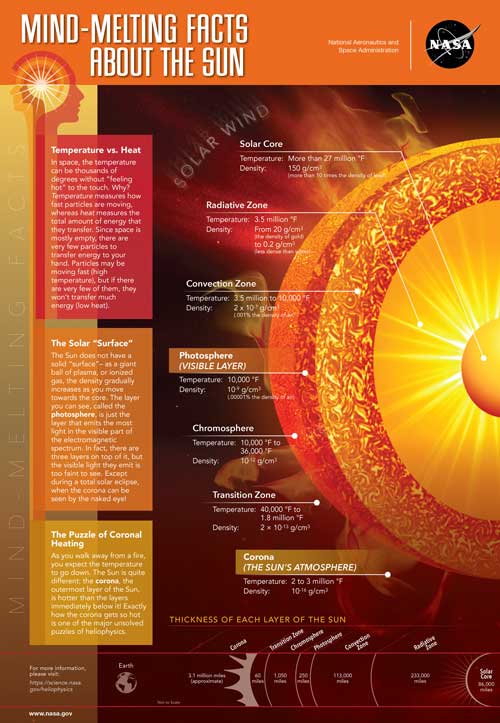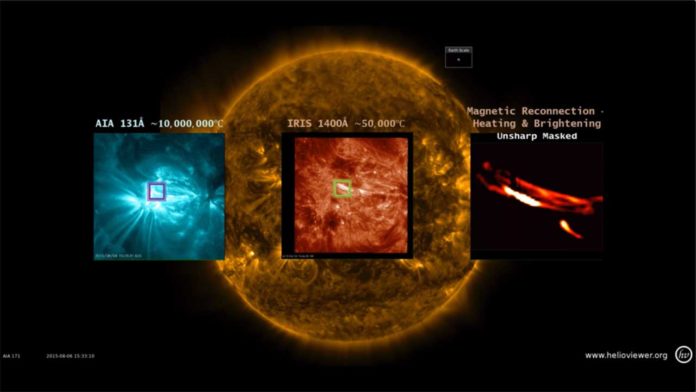A billion times less energetic than ordinary flares, nanoflares have a power that belies their name. A typical ‘nanoflare’ has the same energy as 240 megatons of TNT.
Nanoflares, tiny eruptions on the Sun- are one-billionth the size of normal solar flares. First predicted in 1972 by Eugene Parker, nanoflares are expected to help solve a major puzzle: the coronal heating problem.
How Sun’s outer atmosphere, or corona, gets so incredibly hot?
This question remains unsolved even after a half-century as it is hard to confirm any of a handful of different theories, in part because no one has ever actually seen a nanoflare.
Nanoflares are extremely difficult to observe. Many telescopes are powerful enough to resolve them, but seeing a tiny flash isn’t enough. There is a lot of things to be considered a true nanoflare sighting.
Whenever you detect a corona-heating nanoflare, you have to check two facts:
- First, like regular flares, a nanoflare is set alight by magnetic reconnection. If some other process heats the eruption you’re seeing; it’s not a nanoflare.
- Second, the nanoflare has to heat the corona, which might lie thousands of miles above where they erupt. That’s not trivial – many other solar eruptions only heat their immediate surroundings.
Shah Bahauddin, Research Faculty at the Laboratory of Atmospheric and Space Physics at the University of Colorado, Boulder, for the study, focused on some tiny bright loops at about 60 miles across. The loops are tiny on Sun scales, hence can be noticed flickering in the layer just below the super-hot corona.
Bahauddin said, “I thought maybe the loops made the surrounding atmosphere a bit hotter. I never thought that it would make so much energy that it might propel hot plasma to the corona and heat it.”
Bahaudding zoomed in on images taken by NASA‘s IRIS satellite, he got two surprises:
- First, these loops were incredibly hot – millions of degrees hotter than their surroundings.
- But even stranger, this heat was distributed unusually – differently than in most other physical systems.
The Sun contains elements such as hydrogen, helium, and smaller amounts of every other element. In these loops, heavier elements such as silicon were much hotter and more energetic than lighter elements, such as oxygen.

Bahauddin said, “The heavier elements were shooting out at about 60 miles per second, while the lighter ones were almost at zero. That was completely counterintuitive.”
This observation indicates that something strange is happening in these bright loops.
Amy Winebarger, a solar physicist at NASA’s Marshall Space Flight Center in Huntsville, Alabama, said, “That was a big clue. You had to start thinking about what kind of heating could impact the oxygen atom differently than the silicon atom.”
Bahauddin spent the following years running computer simulations, testing out different heating mechanisms. The key was in the aftermath. As magnetic field lines twist and re-align, they create a short electric current that accelerates the newly-freed ions. Bahauddin likens it to a panicked crowd.
Bahauddin said, “It’s like everyone in a room is trying to run at the same time. They start to collide with each other, and there’s a big mess.”
“Critically, the longer an ion can keep moving in an electric field, the more energy it gains. This is where heavier ions, like silicon, have an advantage. Since they have more momentum, they can plow through the crowd and steal all the available energy.”
“In other words, the more massive silicon ions bulldozed their way through the chaos, soaking up the energy from the electric field. The lighter oxygen ions couldn’t do that – they were stopped dead in their tracks after each collision. This mechanism could explain their results, but still, it was a longshot. The simulations showed that this process only happened under quite specific conditions.”
“To make this happen, you needed a specific temperature, and you needed the right proportion of silicon to oxygen. So we looked back at the measurements and saw that the numbers exactly matched. Remarkably, the conditions on the Sun mirrored his simulations.”
So far, these bright loops appeared to be tiny flares – but did their heat reach the corona?
Bahauddin looked to NASA’s Solar Dynamics Observatory, which carries telescopes tuned to see the extremely hot plasma only found in the corona. Bahauddin located the regions right above the brightenings shortly after they appeared.
Bahauddin said, “And there it was, just a 20-second delay. We saw the brightening, and then we suddenly saw the corona got super-heated to multi-million-degree temperatures. SDO gave us this important information: Yes, this is indeed increasing the temperature, transferring energy to the corona.”
Bahauddin documented ten instances of bright loops with similar effects on the corona. Still, he hesitates to call them nanoflares.
Bahauddin said, “Nobody knows because Nobody has seen it before. It’s an educated guess, let’s say.”
Journal Reference:
- Bahauddin, S.M., Bradshaw, S.J. & Winebarger, A.R. The origin of reconnection-mediated transient brightenings in the solar transition region. Nat Astron (2020). DOI: 10.1038/s41550-020-01263-2
